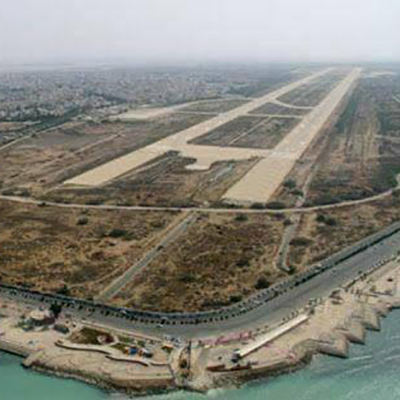Sites
Sixth Tactical Fighter Base of Bushehr
Written by: Mohsen Shirmuhammad
Translated by: Hadi Qorbanyar
15 Views
The Bushehr Air Base was a key defensive installation protecting southern Khuzestan and the northern Persian Gulf during the Sacred Defense. In 1965, a plan was developed to establish a tactical fighter base aimed at securing the country’s air defense, protecting the skies from enemy aircraft incursions, and ensuring regional security in the Persian Gulf. Following initial studies, the base was constructed along the southern edge of Bushehr city, near the coastline. In 1970, with the arrival of F-5 fighter jets, the Sixth Tactical Fighter Base of Bushehr (also known as Bushehr Base) officially began operations as a combat unit. Its capabilities were further enhanced in 1976 with the deployment of F-4 Phantom aircraft.[1]
By 1980, the base housed 50 F-4 Phantoms and 79 pilots.[2] It was among the airfields targeted by Iraq on September 22, 1980, though only the runway sustained damage, which was repaired later on.[3] In response to the attack, four F-4 aircraft took off from Bushehr that same afternoon at 4:30 PM, under the command of Major Pilot Jahangir Ebn-Yamin. After crossing the Arvand River, they entered Iraqi territory and bombarded the Shaibah Air Base in Basra Governorate, returning safely to Bushehr.[4] On September 23, 1980, Bushehr Base launched a new wave of operations in which 30 F-4 aircraft targeted the Shaibiah Air Base, military installations in Al-Faw, and enemy forces in Shalamcheh.[5] Among Bushehr Base’s operations in 1980 were engagements against the Iraqi Navy and airstrikes targeting port facilities in Basra, Al-Faw, and Umm al-Qasr.[6] One of its most critical contributions was the bombing of Iraqi ground forces in southern Khuzestan, which significantly slowed the enemy’s advance. Air support for Iranian troops in this region was coordinated under the Army’s Arvand Command Headquarters. They included Operation Kouy-e Zolfaqari and the destruction of a floating bridge Iraq had built over the Bahmanshir River, and preventing Iraqi ground forces from entering Abadan on October 31, 1980.[7] Likewise, the Sixth Tactical Fighter Base played a pivotal role in Operation Morvarid, which led to the destruction of Iraq’s naval capabilities. This joint operation was launched by the Iranian Navy and Air Force against the Iraqi warships and the oil platforms of Al-Bakr and Al-Amaya on November 28, 1980. The Iranian Air Force conducted 67 sorties during the operation, most of which were from Bushehr Base.
During Operation Morvarid, 11 Iraqi combat vessels, 13 fighter aircraft, and one helicopter were destroyed. Following heavy losses, the Iraqi Navy was no longer able to operate meaningfully in the Persian Gulf throughout the rest of the war. Furthermore, Iraq’s oil exports from the Al-Bakr and Al-Amaya platforms were effectively halted. In the course of the operation, one Phantom jet from Bushehr Base was downed, and both of its pilots were martyred.[8]
Bushehr Base also contributed to the series of operations aimed at liberating Khuzestan. During Operation Thamen al-Aemmah (as) and the breaking of the siege of Abadan, the base provided air support for Iranian troops in the eastern Karun region.[9] The peak of its involvement took place on September 27, 1981, when four Phantom jets from Bushehr entered the skies over the occupied Mared region east of Karun. Despite being targeted by SAM-2 and SAM-3 missiles, they successfully bombarded Iraq’s 3rd Armored Division Headquarters.[10]
The Sixth Tactical Fighter Base also contributed to operations Tariq al-Quds[11] and Beit al-Muqaddas which led to the liberation of Khorramshahr.[12] In Beit al-Muqaddas, several Phantom jets from Bandar Abbas Base were deployed to Bushehr to reinforce Iran’s air capabilities. The base’s most intense activity took place on April 27, 30, and May 1, 6, and 7, 1982, when Phantom aircraft attacked enemy positions.[13]
One of Bushehr Base’s key roles was protecting oil fields in the northern Persian Gulf and escorting convoys of tankers and cargo ships to Kharq Island and Bandar Imam. In response to repeated Iraqi airstrikes on Kharq Island, intended to disrupt Iran’s oil exports, the then-Deputy Commander of the Iranian Air Force, Abbas Babaei, ordered the transfer of an F-14 squadron from Isfahan to Bushehr in late 1985. It allowed for faster, more precise patrols and interceptions over the Persian Gulf to keep shipping lanes safe.[14]
Throughout the Imposed War, aircraft from Bushehr Base flew a total of 10,870 combat sorties. 89 personnel of the base, including 63 pilots, were martyred.[15]
Mahdi Dadpey[16] and Ali-Reza Namaki-Araqi[17] were among the most distinguished commanders of the Sixth Tactical Fighter Base of Bushehr during the Sacred Defense. The current commander is Brigadier General (Second Class) Pilot Nematollah Sadouqi.[18]
Notable pilots who served at Bushehr Base during the war include Abbas Doran, Hussain Khalatbari, Homayoun Shoqi, Ali Amjadian, and Hassan Taleb-Mehr.[19]
Bushehr Base stayed active after the war, and its strategic role grew even more important once the Bushehr Nuclear Power Plant was completed. These days, the base focuses on staying combat-ready through regular training and exercises, aiming to protect Persian Gulf airspace and safeguard key strategic sites like the nuclear plant and the oil fields in Kharq and Assaluyeh.[20]
One of the major postwar initiatives at Bushehr Base was the restoration of damaged aircraft. Beginning in 2008, a phased refurbishment program was launched, resulting in the successful return of 13 Phantom jets to operational status by 2016.[21] Since 2013, the base has also operated a dedicated drone squadron for combat and reconnaissance missions.[22]
[1] Ariyani, Hamed, Paygahi baraye Avvalin Pasokh (A Base for the First Response), Saf, No. 429, Bahman 1395, Pp. 21–22.
[2] Goruh-e Moallefin-e Tarikh-e Defa Muqaddas-e Havaei, Tarikh-e Nabardhay-e Havaei – Ta Aghaz-e Tahajom-e Saraasari-ye Araq (The History of Aerial Battles – Until the Beginning of Iraq’s Full-Scale Invasion), Vol. 1, Tehran, Markaz-e Entesharat-e Rahbordi-ye NAHAJA, 1393, p. 391.
[3] Heyat-e Tadvin-e Tarikh-e Defa Muqaddas, Taqvim-e Mostanad-e Amalkard-e Nirooye Elahi-ye Havaei-ye Artesh-e Jomhouri-ye Eslami-ye Iran (Documented Calendar of the IRI Air Force Performance), Mehr 1359, Vol. 3, Tehran, Markaz-e Entesharat-e Rahbordi-ye NAHAJA, 1397, p. 15.
[4] Ibid., Pp. 21–22.
[5] Ibid., Pp. 78–79.
[6] Namaki, Ali-Reza, Nirooye Havaei dar Defa Muqaddas (The Air Force in the Sacred Defense), Tehran, Entesharat-e Iran Sabz, 1389, p. 162.
[7] Ibid., Pp. 163–164.
[8] Masbouq, Muhammad va Ali-Reza Javaheri, Amaliyat-e Morvarid (Operation Morvarid), Tehran, Markaz-e Entesharat-e Rahbordi-ye NAHAJA, Pp. 185–186.
[9] Namaki, Ali-Reza, Ibid., p. 178.
[10] Ibid., p. 188.
[11] Ibid., p. 212.
[12] Ariyani, Hamed, Ibid., Pp. 21–22.
[13] Namaki, Ali-Reza, Ibid., Pp. 259–265.
[14] Ariyani, Hamed, Ibid., Pp. 21–22.
[15] Ibid., Pp. 21–22.
[16] Namaki Araqi, Ali-Reza va Digaran, Tarikh-e Nabardhay-e Havaei (The History of Aerial Battles), Vol. 3, Tehran, Markaz-e Entesharat-e Rahbordi-ye NAHAJA, 1396, p. 57.
[17] Namaki, Ali-Reza, Ibid., p. 6.
[18] Farmandeh-e Paygah-e Sheshom-e Shekari-ye Shahid Yasini-ye Bushehr Moaarefeh Shod (The Commander of Shahid Yasini Sixth Tactical Fighter Base in Bushehr Has Been Appointed), Khabargozari-ye Mehr, 25 Dey 1399, www.mehrnews.com/news/5122206/
[19] Yahussaini, Seyyed Qasem, Parvaz ruye Khak – Khaterat-e Sarhang Khalaban Manouchehr Shiraaqaei (Flying over the Soil – Memoirs of Colonel Pilot Manouchehr Shiraaqaei), Tehran, Soreh Mehr, 1391, p. 301.
[20] Ariyani, Hamed, Ibid., Pp. 21–22.
[21] Ibid., p. 27.
[22] Ibid., p. 26.





